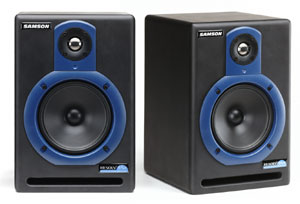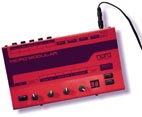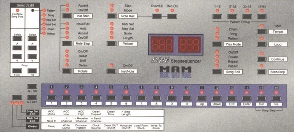Quote of the day: "Allow the president to invade a neighboring nation, whenever he shall deem it necessary to repel an invasion, and you allow him to do so whenever he may choose to say he deems it necessary for such a purpose--and you allow him to make war at pleasure." --Abraham Lincoln

First and foremost was the purchase of an Egnater M4 guitar preamp. This is a modular all-tube preamp designed by one of the great modern amplifier designers: Bruce Egnater. Several modules are available for the M4--I have the Fender Deluxe, Fender Bassman, and Marshal Super Lead + (four modules can be inserted into an M4, but I only got three since I wanted to listen to the sounds and then choose the fourth module to cover what I was missing). Egnater equipment is very well built by a few guys at the Egnater company. It is definitely 'boutique' equipment which sometimes takes a while to get since it is all built by hand. The sounds are really great. There is nothing like tube distortion! Prior to getting the M4 I bought a Tech 21 SansAmp PSA-1 which is a transistor-based preamp. A lot of people like the PSA-1 for high-distortion sounds but I didn't like it at all for anything other than clean (very good) or high distortion (passable). For low distortion levels, the PSA-1 has a very strange sound, sometimes described as a broken kazoo. I admit that it may sound better through speakers (I was listening through headphones), but I had to return it in the end because it just wasn't what I wanted. I was looking for a versatile preamp with good basic sounds ranging from clean . Ideally it would also have MIDI control of parameters, or at least MIDI recall of patches. Here the M4 doesn't quite measure up--it only has MIDI selection of modules, which means selection of up to four different sounds. But I decided to focus on sound as my first priority and thus I was willing to sacrifice some control. The only product that would have completely satisfied all my requirements was the Engl E580 preamp, but the price was much more than I could afford (and I haven't heard any demo sounds from the E580, so I'm just assuming I would be happy with the sound). I'm not complaining about the M4, though. The sound is what really matters...

Although the M4 is a great preamp, a preamp alone doesn't sound quite right. What's missing is the effect of the power amp (with it's own characteristic distortion effects if it's a tube unit) and the speakers. If playing quiet is not a constraint, then getting a tube power amp and a speaker cabinet is the way to go. However, living in an apartment and needing to play late at night (sometimes) makes this a non-option. In this case, what's needed is a amp/speaker simulator. There are products out there that simulate power amp characteristics (usually by using a preamp tube which is an approximation at best) and/or others that simulate speaker characteristics. Initially I was using the speaker simulator on my Digitech RP-7 unit, and I also used the speaker simulator on my Zoom PSA1 as well. Neither sounded very good to me (and I wanted a rackmount unit), so I bought a Palmer PGA05 - ADIG-ST stereo guitar amp simulator. This is a fairly expensive unit, but it does a great job of simulating speakers--although it attempts to simulate some characteristics of amplifiers, it is primarily a speaker simulator in that it cannot simulate the compression/distortion effects of a real power amplifier. However, I get good results by adding some compression with my G-Major after the PGA05 and I am satisfied with the results through headphones. I have to admit that the sound is much better through my powered speakers (see below), where the added effects of real speakers enhances the sound. In the end, the sound of the M4 into the PGA-05 into the G-Major (compression + reverb) is way better than any other all-in-one DSP-based unit I have used (although the G-Major is DSP-based, the algorithms are better and the DSP is only providing compression and reverb; not distortion, amp simulation, and speaker simulation plus effects as on the all-in-one units). Even though my current setup is very good, I am considering going all analog in the future by purchasing a good rackmount compressor and spring reverb unit. But, for now, I am happy with the sound I'm getting!

I also bought some Samson reference monitors, model Resolv 65a. These are good quality active speakers with a 6.5" woofer and 1" tweeter. They are also bi-amp, which means a separate amplifier is used for the woofer (75W) and tweeter (25W). They sound very nice for the price--certainly not as good as some of the exotic studio monitors (over $2000 a pair), but good enough for me. The only problem I've had is a cutout problem, most likely due to overheating when I have turned them up very loud.

The Nord Micro Modular is a small modular synthesizer made by Clavia. It is the smaller brother of the Nord Modular keyboard and rackmount units. The concept was quite innovative when it was introduced: edit the configuration of the modular synth using a PC editor, and then download the configuration to a DSP in the hardware. This gives the user a good interface for wiring up modules (yes, you actually connect modules with virtual wires) plus no CPU drain when generating sounds. Among dedicated synthesists the Nord Modular line was a big hit (many purists prefer an analog modular synth, but they are very expensive as each module must be purchased separately). Recently, Clavia discontinued the original Modular line in order to focus on their new G2 Modular hardware. The result was a blowout price on the remaining units in stock, and I picked up a Mocro Modular from Nova Musik for $300 (the original price was around $900). This is a fun unit to play with, although I haven't done much more than play with the factory patches. When I get some time I'm going to get serious about learning synthesis, but for now there are thousands of patches available online covering just about any type of sound. One thing I'm using it for is electronic drums with my new sequencer (see below). Another possibility is guitar processing, since the Micro Modular has an audio input. Thus the guitar signal can be processed instead of the normal oscillator signals, allowing for some wild effects!
